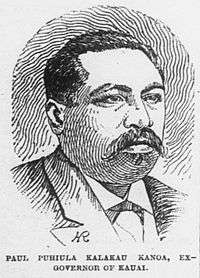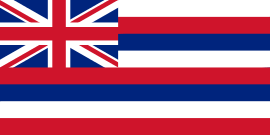Paul P. Kanoa
| The Honorable Paul Puhiula Kanoa | |
|---|---|
|
Kalākaua, Antone Rosa, and Paul Kanoa inspecting the Kaimiloa | |
| Royal Governor of Kauaʻi | |
|
In office January 12, 1881 – 1886 | |
| Preceded by | Frederick W. Beckley |
| Succeeded by | Lanihau |
| Personal details | |
| Born |
June 10, 1832 Honokaupu, Honolulu, Oʻahu |
| Died |
March 18, 1895 (aged 62) Koula, Honolulu, Oʻahu |
| Resting place | Kawaiahaʻo Church |
| Nationality | Kingdom of Hawaii |
| Political party | National |
| Spouse(s) | Kaleipua |
| Relations |
Kaiakauleheleheokaoleioku or Kaʻaʻaikaulehelehe (biological father) Kapau (biological mother) Paul Kanoa (hānai father)[1] |
| Children | two daughters |
| Residence |
Koula (in Honolulu) Niumalu (in Līhuʻe) |
| Occupation | Politician |
Paul (Paulo) Puhiula Kanoa (June 10, 1832 – March 18, 1895) was a noble and politician in the Kingdom of Hawaii from the island of Kauaʻi.
Life
.jpg)
Paul Puhiula Kanoa was born June 10, 1832 in Honolulu.[2] His hānai father, usually known as Paul Kanoa served as Royal Governor of Kauaʻi, from 1847 to 1877,[3] and died in 1885. Since the two are often confused, the father is sometimes called "Sr." and the son "Jr."
On December 18, 1875 Kanoa became a land appraiser for the island of Kauaʻi. On January 12, 1881 he was appointed as Royal Governor of Kauaʻi. King Kalākaua appointed him to the House of Nobles in the legislature of the Hawaiian Kingdom from 1882. He was appointed minister of finance on June 30, 1886.[4][5] He was a founding member of a civic club called Hale Nauā in September 1886 which combined aspects of Freemasonry and ancient Hawaiian practices.[6] This cabinet was widely seen as under the influence of Claus Spreckles. The other members, under Walter M. Gibson had no other political experience in Hawaii.[7] He kept his post in a cabinet reshuffle in October 1886, but resigned on July 1, 1887, after the 1887 Constitution of the Kingdom of Hawaii (known as the Bayonet Constitution) forced another change in government. After the House of Nobles became elected, he won the seat in 1890 and 1892.[4]
He married Kaleipua on December 15, 1856 and died March 18, 1895 in his sleep.[2] The site of the family estate is now the Niumalu Beach Park.[8] The area was also the residence of William Charles Achi, Jr. and his family.[9] The Territory of Hawaii set up the offices of Kauaʻi County on the hill above the beach, and the site later became Kauai High School.[10]
References
| Wikimedia Commons has media related to Paul P. Kanoa. |
- ↑ "KANOA, PAULO Alii Award LCA 8305" (PDF). Kanaka Genealogy web site. Retrieved May 13, 2012.
- 1 2 "Paul P. Kanoa Dead: passing of a Notable Figure in Hawaiian Affairs" (PDF). The Daily Bulletin. Honolulu. March 18, 1895. p. 1. Retrieved October 30, 2011.
- ↑ "Kanoa, Paulo Sr. office record". state archives digital collections. state of Hawaii. Retrieved August 2, 2010.
- 1 2 "Kanoa, Paul Puhiula Jr. office record". state archives digital collections. state of Hawaii. Retrieved August 2, 2010.
- ↑ Newbury, Colin (2001). "Patronage and Bureaucracy in the Hawaiian Kingdom, 1840–1893". Pacific Studies. Laie, HI: Brigham Young University, Hawaii Campus. 24 (1–2): 13, 16, 29. OCLC 607265842.
- ↑ Frank Karpiel (1999). "The Hale Naua Society". Hawaiian Journal of History. 33. Hawaii Historical Society. p. 209. Retrieved August 2, 2010.
- ↑ Ralph Simpson Kuykendall (1967). Hawaiian Kingdom 1874-1893, the Kalakaua Dynasty. 3. University of Hawaii Press. p. 292. ISBN 978-0-87022-433-1.
- ↑ John R. K. Clark (April 1990). Beaches of Kaua'i and Ni'ihau. University of Hawaii Press. p. 2. ISBN 978-0-8248-1260-7.
- ↑ Moke Kupihea (March 31, 2004). The Seven Dawns of the Aumakua: The Ancestral Spirit Tradition of Hawaii. Inner Traditions / Bear & Company. pp. 244–245. ISBN 978-0-89281-144-1.
- ↑ "School is a history class". Honolulu Star-Bulletin. February 18, 2008. Retrieved August 2, 2010.
| Government offices | ||
|---|---|---|
| Preceded by Frederick W. Beckley |
Royal Governor of Kauaʻi 1886–1887 |
Succeeded by Lanihau |
| Preceded by Charles T. Gulick |
Kingdom of Hawaii Minister of Finance 1886–1887 |
Succeeded by William Lowthian Green |

